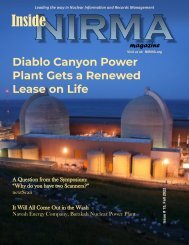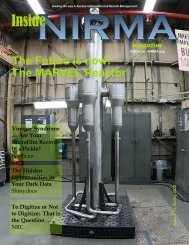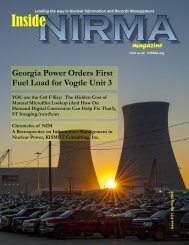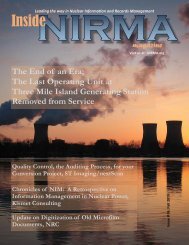Inside NIRMA Fall 2020
You also want an ePaper? Increase the reach of your titles
YUMPU automatically turns print PDFs into web optimized ePapers that Google loves.
What Refueling a<br />
Nuclear Reactor<br />
During COVID-19<br />
Taught the<br />
Industry<br />
As the coronavirus pandemic<br />
continues, we’ve all had to adapt.<br />
Increasingly, the health crisis highlights<br />
how essential electricity is to our daily<br />
lives—from remote work to family<br />
Zoom calls.<br />
America’s 94 nuclear plants have also<br />
adjusted to these new circumstances<br />
and have continued to provide reliable,<br />
carbon-free energy to keep the<br />
electricity flowing. This was especially<br />
evident during the spring when COVID<br />
-19 brought new challenges to the<br />
seasonal effort to refuel 30 nuclear<br />
reactors across the country. This fall,<br />
the nuclear industry will take valuable<br />
lessons learned from that success as it<br />
prepares to refuel another two dozen<br />
reactors.<br />
What the Industry Learned<br />
Safety is the highest priority of every<br />
U.S. nuclear plant and there were no<br />
exceptions last spring as the nuclear<br />
energy industry worked to minimize the<br />
spread of coronavirus during refueling<br />
outages.<br />
Nuclear plants employ hundreds of<br />
workers and during a refueling outage,<br />
they bring in hundreds more people for<br />
maintenance and inspections. A nuclear<br />
plant is mostly a hands-on workplace,<br />
but innovative nuclear service<br />
companies were able to use new<br />
tools so some activities could be done<br />
remotely. For workers who still need to<br />
go on-site, the industry has changed its<br />
approach to scheduling duty shifts for<br />
certain plant personnel, keeping some<br />
of them together consistently in teams<br />
to reduce the opportunities for virus<br />
transmission.<br />
Many nuclear plants also worked with<br />
regulators to find changes in procedure<br />
to reduce the opportunities for<br />
infection, like postponing some annual<br />
medical exams or security guard<br />
weapons range activities as well as other<br />
lower priority maintenance activities.<br />
In addition to those broad efforts,<br />
plants were able to take on smaller—<br />
though no less effective—changes.<br />
These included decontaminating the<br />
buttons and switches in control rooms,<br />
extensive sanitizing of other<br />
workplaces, being ahead of the curve in<br />
marking the floors at six-foot intervals<br />
for social distancing, and requiring<br />
social distancing, mask-wearing and<br />
handwashing on-site, as well as<br />
encouraging the same practices outside<br />
of the workplace. Some plants even<br />
supplied employees with meals and<br />
groceries for their homes to help<br />
minimize the time that they needed to<br />
be in public areas.<br />
What the Industry Is Still Doing<br />
As we’ve seen, the days of COVID-<br />
19 have required extra equipment, extra<br />
precautions and an added sense of<br />
responsibility beyond just yourself. This<br />
is true when wearing a mask in public or<br />
assuring a reliable electricity supply.<br />
Nuclear operators have always been<br />
adept at working together across the<br />
industry; during the pandemic, this was<br />
even more valuable. Plants knew how to<br />
screen people at the plant gate for<br />
warning signs, like a fever or cough, or<br />
report if someone was sick at home. But<br />
they improved on that and learned to<br />
share this information across the<br />
industry.<br />
The industry has also continued to<br />
think ahead; it’s part of why nuclear<br />
energy is prepared for any emergency.<br />
Plants have had pandemic response<br />
plans since 2006 and updated them<br />
early this year before the virus first<br />
surged in the U.S. These plans included<br />
measures we consider standard today<br />
such as using protective equipment like<br />
masks, and exercising social distancing.<br />
Because of the possibility of<br />
hurricanes or other extreme weather,<br />
nuclear plants are also prepared to keep<br />
crews in the plants if necessary, with<br />
housing, food and other necessities, so<br />
that their vital work can continue, a<br />
precaution that could be used in a<br />
pandemic. Additionally, plants have also<br />
continued to identify people who could<br />
fill critical roles if others fall ill, and to<br />
exchange information and pool insights<br />
with reactor operators around the<br />
world.<br />
What’s Next<br />
The novel coronavirus has defied<br />
almost everyone’s ability to predict, but<br />
there’s one thing we can be assured of:<br />
Electricity will be essential to the<br />
recovery we all seek.<br />
As certain plants look to refuel their<br />
reactors this season, the industry is<br />
looking ahead as always to keep the<br />
lights on with reliable, carbon-free<br />
energy. With the lessons learned from<br />
operating during a pandemic and with<br />
the industry’s culture of preparedness,<br />
nuclear energy is ready for the next set<br />
of refueling outages.<br />
Article reprinted with permission<br />
of NEI. Read full article here.<br />
24 <strong>Fall</strong> <strong>2020</strong> <strong>NIRMA</strong>.org <strong>Inside</strong> <strong>NIRMA</strong>
















